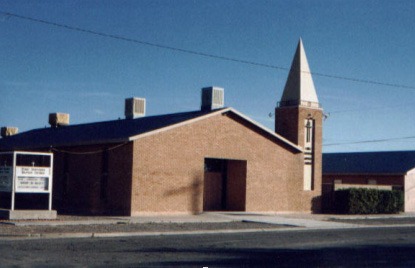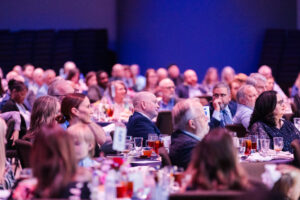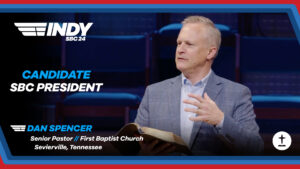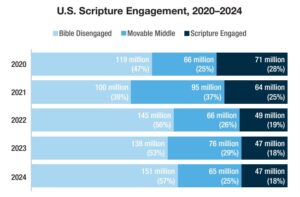
WILLCOX, Ariz. (BP)–Fifty years ago, Albert Faulk, a native Texan and pastor of a Southern Baptist church in Duncan, Ariz., realized that a nearby town was lacking something vital — a Southern Baptist church.
The town of Willcox, Ariz., about 75 miles southwest of Duncan, had a Southern Baptist church there many years earlier, but in the 1920s, the First Baptist Church in Willcox changed its affiliation to the Northern Baptist Convention and later to the Conservative Baptist Association of America, a Colorado-based denomination founded in 1947, now with about 1,200 churches.
Faulk was burdened for the town of Willcox, so in January 1953 he began a house-to-house canvass to determine the prospects for a Southern Baptist church there. As a mission of the church at Duncan, he began holding Sunday School, Training Union, prayer and preaching services in the music room of the Willcox Elementary School.
In April 1953, the Willcox mission was organized into the First Southern Baptist Church with 16 charter members. The new church immediately petitioned the local Baptist association for affiliation and soon received help from the Baptist General Convention of Arizona, now known as the Arizona Southern Baptist Convention. The church also received monetary help from the Home Mission Board (now North American Mission Board) of the Southern Baptist Convention in the form of a monthly $100 pastor’s salary supplement for one year, then $75 per month for another year. The church then released NAMB from the commitment after two years, according to Stuart Willoughby, a charter member of the church, in his historical account for the church’s 25th anniversary in 1978.
Faulk served many months on the meager salary and supported himself and his family by outside employment.
In July 1953, the church voted to give 10 percent of its undesignated receipts to the Cooperative Program, Southern Baptists’ unified giving plan, and the percentage was increased to 15 percent in October of that year.
The first church budget of $100 per month was adopted in October 1953, with the pastor’s salary at $50, the rent and janitor at $20, Cooperative Program at $15 and literature and miscellaneous at $15.
By the end of 1953, membership had increased to 28 and the church was engaged in mission activity in at least five other locations.
In January 1954, one year after the church was organized, it began looking for a building to call its own. Negotiations at the Grace Bible Baptist Church fell through when the owner of the property wanted a merger of the two congregations with himself as pastor. The church then looked elsewhere and settled on a former Pentecostal Holiness church building.
The tiny adobe stucco structure consisted of a small auditorium and two small classrooms in the rear. The right front corner of the structure was cracked so that daylight could be seen through it from the inside.
“It was a very unattractive sort of structure, but to the members of the little church still meeting in a classroom at the grammar school, it looked like a veritable cathedral,” Willoughby wrote.
The former Pentecostal Holiness building could be purchased for $2,000, and the members of the church borrowed the sum from a local bank on a short-term note upon assurance from the state convention that by the time it fell due, the convention’s Trust Memorial Fund would lend the money to buy it. The congregation moved into the building in February 1954.
With its organization now complete, Faulk resigned as pastor of the church in June 1954, and the church called a series of pastors throughout the years.
In October 1954, the church applied to the Home Mission Board for a loan of $6,000 in order to repay the original $2,000 loan and build a larger auditorium on the east side of the property. The loan was granted, and the men of the church slowly raised the new building, according to the historical account. The church moved into its new structure in August 1955 and continued to use the old building for classrooms.
Gifts to the Cooperative Program from the church varied in the early years from a low of 8 percent in 1966 and 1967 to a high of 19 percent from 1969-71. By 1968, total membership had increased to 319 and total receipts were just over $22,000.
The church continued mission work, including outreach to the African American and Hispanic communities in Willcox.
In 1959, an additional loan from the Home Mission Board was secured, and additional educational rooms were added to the rear of the old auditorium. In 1962, the church demolished the original Pentecostal Holiness building and built another auditorium with the help of the state convention. The other auditorium was converted to educational space.
A noteburning service was held in November 1976 to celebrate a debt-free congregation.
Faulk and his wife, Gerri, returned to the church between church plants and now have settled there.
“It really bothered Bro. Faulk that there was no Southern Baptist church in town,” said the church’s current pastor, Ken Henderson. “He had a passion then and has a passion now.”
Dorothy Stroud, the church clerk and member of the congregation for 40 years, said the church has faced challenges during its 50 years simply because it lacks the resources that churches in the Bible Belt enjoy. Many of its 400-plus members have stopped attending regularly, and the average weekly attendance has dwindled.
“This area is still a mission field, and when a little church makes it in this environment for 50 years, it’s unique and wonderful,” she said.
The First Southern Baptist Church of Willcox will celebrate its 50th anniversary April 26 and 27 with a “Kingdom Homecoming” picnic on the grounds, music and fellowship followed by a special worship service.
–30–
(BP) photos posted in the BP Photo Library at http://www.bpnews.net. Photo titles: BEACON OF THE COMMUNITY and TOWN’S BAPTIST PIONEERS.














